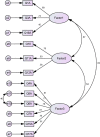Development and validation of a white cane use perceived advantages and disadvantages (WCPAD) questionnaire
- PMID: 37649118
- PMCID: PMC10466727
- DOI: 10.1186/s40359-023-01282-4
Development and validation of a white cane use perceived advantages and disadvantages (WCPAD) questionnaire
Abstract
Background: The white cane is globally an important tool in orientation and mobility for blind and visually impaired people, but it is not often used. The goal of this study was to develop and validate the white cane use perceived advantages and disadvantages (WCPAD) questionnaire for detecting effective factors in the use or non-use of canes.
Method: The initial questionnaire items were extracted through semi-structured interviews with 21 blind or severely impaired vision individuals under two main themes, the perceived advantages, and disadvantages of using a white cane. Linguistic validity and writing evaluation with seven experts, face validity with 23 blind persons, content validity ratio (CVR), and content validity index (CVI) were used for assessment of validity. Internal and external reliability assessment was done using Cronbach's alpha and intra-class correlation coefficient (ICC). Explanatory factor analysis was conducted to identify the factors of the questionnaire; then, corrected item-total correlations, convergent and discriminant validity, and Confirmatory Factor Analyses (CFA) were done, and model fit indices were reported. A total of 320 blind and severe visual impaired individuals (138 males and 182 females) participated in the study. The final questionnaire contained 12 questions in perceived advantages and 21 in perceived disadvantages.
Results: Three factors (social participation, mobility, and culture) extracted for perceived advantages which explained 67.95% of the total variance, Cronbach-α for the three extracted factors was between 0.75 and 0.91. Four factors (social, safety, ergonomics, and family) for perceived disadvantages were extracted which explained 50.98% of the total variance. Cronbach-α for the four extracted factors was from 0.75 to 0.88. CFA confirmed the final models for perceived advantages and disadvantages.
Conclusion: WCPAD questionnaire has good reliability and validity, and the factors obtained from factor analysis can measure the reasons for using or otherwise of white canes.
Keywords: Blind; Ergonomics; Visual impairment; White cane.
© 2023. BioMed Central Ltd., part of Springer Nature.
Conflict of interest statement
The authors declare no competing interests.
Figures
References
-
- Hwang GJ, Xie H, Wah BW, Gašević D. Vision, challenges, roles and research issues of artificial intelligence in education. Computers and Education: Artificial Intelligence: Elsevier; 2020. p. 100001.
-
- Bourne R, Steinmetz JD, Flaxman S, Briant PS, Taylor HR, Resnikoff S, et al. Trends in prevalence of blindness and distance and near vision impairment over 30 years: an analysis for the Global Burden of Disease Study. Lancet Glob Health. 2021;9(2):130–143. doi: 10.1016/S2214-109X(20)30425-3. - DOI - PMC - PubMed
MeSH terms
Grants and funding
LinkOut - more resources
Full Text Sources
Medical



